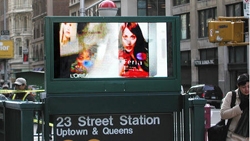Lessons learned in New York’s subway digital signage network

Eighty 25in x 50in subway entrance digital displays in New York City – installed by UDN and managed through wireless technology – are providing outstanding “return on space” and a highly cost-effective venue for advertisers, according to an evaluation of the network’s first year of operation.
New York’s subway digital signage network – with some 80 displays at subway entrances – offers some valuable lessons to digital signage users and suppliers as it celebrates its first birthday. Significant advances have been made in digital signage during 2004 – and 2005 is shaping up to be another busy year for dynamic digital signage.
Digital signage is being called "the last mile of a marketing program," offering more cost-effectiveness, flexibility and control at product and service selection locations. Many retailers such as Apple, McDonald’s, Bank of America, Circuit City, Safeway, Sears, Virgin Music, US Postal Service and Nike, have run successful pilots during 2004.
At the same time, some of the firms shifting ad spending to digital signage include astute media buyers and brand-builders such as Bayer, Black & Decker, Colgate-Palmolive, Disney, DIRECTV, Frito-Lay, General Mills, Heinz, Kodak, L’Oreal, Minute Maid, Nestle, Sara Lee, Starter, The New York Times, LG Mobile Phones, ABC, FOX, Univision and Lee Jeans.
Four key lessons learned in New York:
- "Build it and they will come." The pressure to get more results from advertising continues to grow as digital signage takes an increasing cut of an overall $149 billion annual investment in advertising. At one end of the scale, cost per thousand (CPM) rates of $2 to $6 make digital signage an inexpensive media buy. There is a question of how long this bargain will last as performance is increasingly proven and more advertisers take advantage of this powerful new communications medium. Revenue increases of 30 percent and more are being realized on products profiled, with striking results such as a 109 percent sales increase for a new soft drink and 319 percent for a new calling card. Digital signage in bank teller lines results in customer inquiries about new services.
- "Wireless networking is effective." This is important for signage location flexibility and deployments in harsh, highly obstructed environments. According to UDN, the company that installed the New York network, wireless networking has performed well and the system has had no image drops. Wi-fi 802.11 using multi-polarity antennas from WiFi-Plus (www.wifi-plus.com) has provided reliable, secure and cost-effective connectivity for the 80 New York street-level LED panels. Interactive content provider BTV said cost-effective, reliable, fully secure and interactive image transport done wirelessly by satellite has long been used for interactive distance learning (IDL) and business television applications. The company said that digital signage applications benefit from the cost-effectiveness, location flexibility, security and reliability that satellite connections provide for digital (IP) communications.
- “Ensure content integrity and security.” System security may be inadequate at the network design stage, or be exposed as digital signage systems expand and use multiple media transport providers (Internet service providers, or ISPs). According to UDN, the system must be nearly "bullet-proof" to hackers. Signage software providers such as Automated Digital Signage Networks (www.adsn.ca) have taken steps to ensure security at the content ingest, playlist management, display monitoring and other vulnerable points.
- "Digital signage offers high return on real estate." Digital displays support commerce, public safety and information needs because they are so visual, vivid and eye-catching. Being able to provide information at a point of decision or when information is needed underpins the value of this communications medium for advertisers and public service providers.
Revenue measures from stock turns, margin per square foot or revenues from print (static) signage locations place a value on retail location space. Revenue from dynamic digital display at, for example $10,000 per month per display to the network owner, offers a good "return on space" comparison. The location benefits of use, such as product lift, branding, better customer relationships, liability containment, etc., are adding to the value assessment. The 25x50in LED signs positioned at the street level entrance to New York subways are providing a "return on space" and value along the supply chain from advertiser to signage provider.
Lyle Bunn is senior partner of Apogee Partners, which monitors and reports on important technology trends and developments. White papers on digital signage are available (no cost or registration required) at http://members.rogers.com/apogeepartners/.
Get the TV Tech Newsletter
The professional video industry's #1 source for news, trends and product and tech information. Sign up below.
